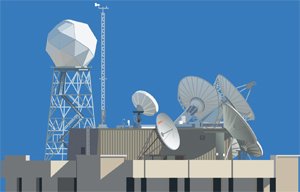UW-Madison’s Newest “Eyes in the Sky”
The Space Science and Engineering Center (SSEC), with its large array of satellite dishes atop its towering building, isn’t the only place on south campus with “eyes in the sky.” The climate research facility has a bird’s eye view of some of the University of Wisconsin-Madison’s newest residents: a nesting pair of red-tail hawks and their three tiny white chicks.

The hawks have nested on a protruding window ledge of nearby Weeks Hall, giving the researchers at SSEC an excellent opportunity to watch the young family grow and prosper. Taking a hint from their own satellite-based research, SSEC researchers have re-purposed a roof-top camera to provide a 24-7 video feed of the nest.
If not pulling “nest duty,” one or another of the proud parents can usually be seen either perched on one of the rooftop instruments of SSEC, or flying high in the sky, peering down in search of the chicks’ next meal.
Male and female red-tailed hawks are nearly identical in appearance, making differentiation from a distance almost impossible. They mate for life and often return to the same nest for several years. They lay up to three eggs in the early spring. After four to five weeks, the eggs hatch and snow white chicks, known as eyasses, emerge, mouths open and hungry. After another six to seven weeks the young raptors will begin to leave the nest for short flights, honing their hunting skills. Ten weeks later they strike out on their own.
Two years ago, hawks built a nest on the Weeks Hall window. Last year they returned and SSEC placed a small video camera to watch them hatch and fledge their young. This year a higher resolution camera provides an even better view.
“Our streaming video web page has had over 50,000 hits and over 30,000 unique visitors since the camera went online in late March,” says John Lalande of SSEC’s Technical Computing Department. “We have had visitors from at least 50 countries so far. Traffic has definitely spiked over the last few days. At the beginning of the week, we might have had around 100 simultaneous viewers. By Thursday, we were over 500. Similarly, hits per day on the web site went from a few hundred a day over the first few weeks to a few thousand per day this week.”
Oblivious to all this attention, the hawks feed their young and prepare them for their own time in the sky.
Satellites orbiting overhead in space, raptors soaring over South Campus, or visitors to the hawk’s streaming web page, many eyes are gazing down on the UW campus.
Back to Front Page

